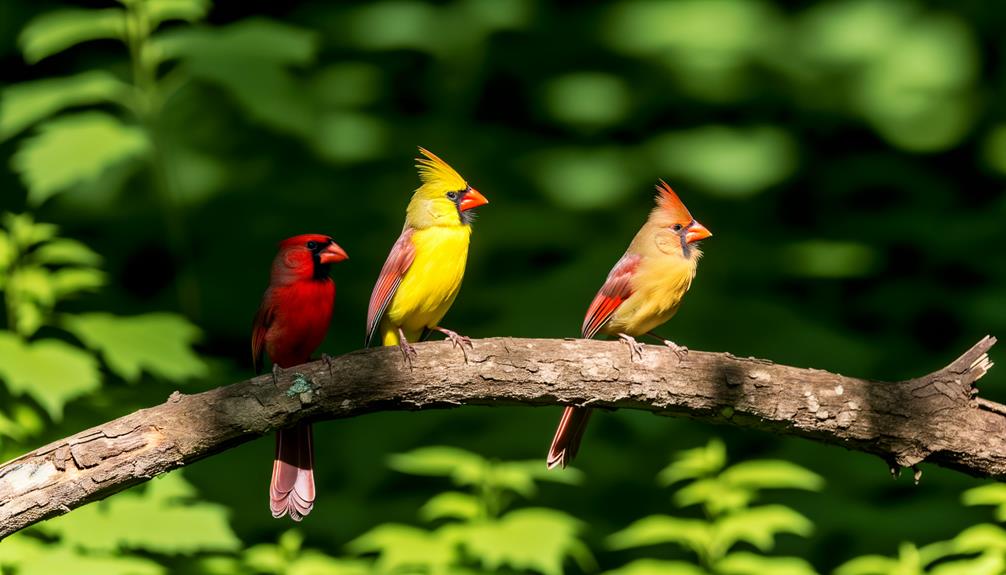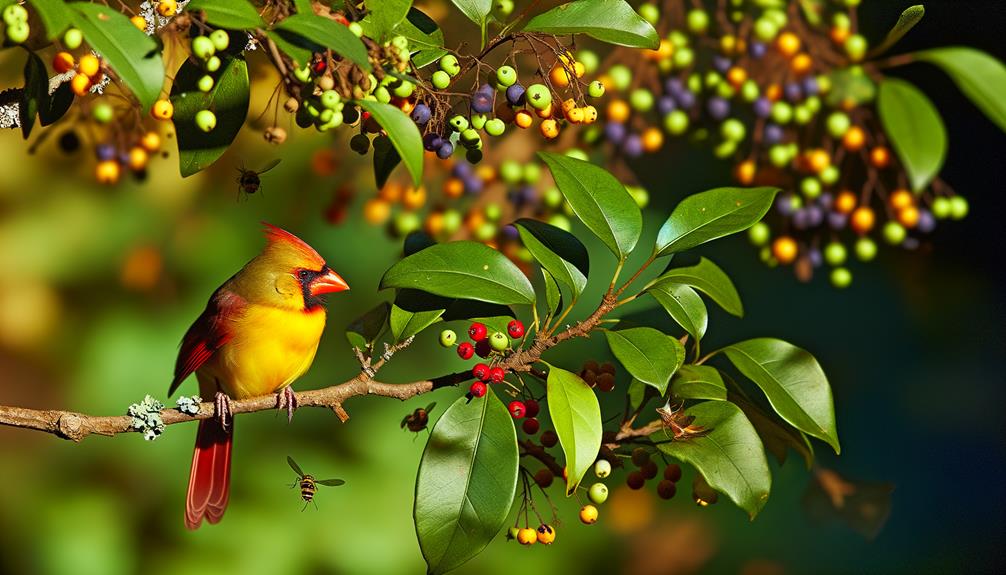What Determines Yellow Cardinal as Male or Female?
Yellow cardinals can be either male or female. Males typically exhibit vibrant yellow plumage, driven by dietary carotenoids and genetic mutations affecting pigment synthesis.
In contrast, females have more subdued yellow tones, aiding in camouflage during nesting. Alongside coloration, behavioral traits such as territorial aggression in males and nurturing behaviors in females assist in sex identification.
Yellow cardinals, occurring once in a million, offer rare insights into the genetic and evolutionary factors influencing avian coloration. Their appearance challenges traditional views on bird pigmentation, making them a unique subject of study in ornithology.
Discover more fascinating details on cardinal behavior and genetics.

Key Takeaways
- Male yellow cardinals exhibit brighter yellow plumage compared to females.
- Female yellow cardinals have more subdued yellow tones.
- Yellow cardinals' gender identification follows similar plumage color patterns seen in red cardinals.
- Genetic mutations causing yellow coloration do not affect gender-specific behaviors.
- Behavioral traits such as vocalizations and territorial displays also aid in identifying male yellow cardinals.
What Is a Yellow Cardinal?

A Yellow Cardinal is a rare color morph of the Northern Cardinal, displaying a striking yellow plumage instead of the typical red. This phenomenon, known as xanthochroism, results from a genetic mutation affecting carotenoid pigments.
Researchers have documented only a few instances, making sightings exceptionally uncommon. Ornithologists note that these birds maintain the same size, shape, and behaviors as their red counterparts. Their diet and habitat requirements remain consistent, relying on seeds, fruits, and insects.
Genetic analysis suggests that the yellow coloration doesn't affect the bird's health or reproductive capabilities. Observers find Yellow Cardinals in the same geographical regions as red ones, mainly in North America. Despite their rarity, they've sparked significant interest among birdwatchers and scientists alike.
Understanding Cardinal Coloration
Although Northern Cardinals are typically known for their vibrant red plumage, the coloration results from a complex interplay of diet-derived carotenoid pigments and genetic factors. These pigments are ingested through a diet rich in fruits and seeds and converted in the body to produce the characteristic red feathers. Genetic factors can affect the efficiency of this conversion, leading to variations in color.
| Color | Factors |
|---|---|
| Red | Carotenoids, Efficient Conversion |
| Yellow | Carotenoids, Inefficient Conversion |
| Brownish | Lack of Carotenoids |
Detailed observations indicate that the intensity of cardinal coloration correlates with dietary quality and genetic disposition. Research shows that environmental factors, like availability of carotenoid-rich food sources, play a critical role in plumage pigmentation. Therefore, understanding cardinal coloration requires analyzing both genetic and environmental influences.
Genetic Mutations in Cardinals

Understanding the role of genetic mutations in cardinals is pivotal, as these mutations can lead to significant deviations from the typical red coloration, including the rare yellow cardinal. Genetic anomalies, such as xanthochroism, alter pigment production, swapping red feathers for yellow.
Researchers have identified specific genetic defects affecting carotenoid metabolism, which underlies this color transformation. Typically, cardinals convert dietary carotenoids into red pigments. However, mutations disrupt this process, resulting in yellow plumage.
Observations indicate these mutations occur sporadically, making yellow cardinals exceptionally rare. Detailed genetic analysis and advanced sequencing techniques have been employed to pinpoint the exact mutations responsible. Understanding these genetic variances not only elucidates avian biodiversity but also underscores nature's unpredictability.
Yellow Cardinal Sightings
Yellow cardinal sightings are an infrequent phenomenon, with reports primarily emerging from the southeastern United States. Ornithologists have documented these rare avian specimens in states such as Alabama and Florida, suggesting a limited geographic distribution.
These observations contribute valuable data to the understanding of genetic variations in cardinal populations.
Rare Bird Spotting
Spotting a yellow cardinal, a rare genetic mutation known as xanthochroism, has intrigued ornithologists and bird enthusiasts alike due to its infrequency and striking appearance. Documented cases reveal detailed observations of its unique plumage, contrasting vividly with the typical red cardinal. Researchers have noted this phenomenon provides insight into avian genetics and pigment variations.
| Observation | Details |
|---|---|
| Plumage Color | Bright yellow, replacing standard red |
| Frequency | Extremely rare, few sightings recorded |
| Genetic Mutation | Xanthochroism, affecting pigment production |
Such sightings are sporadic, yet they offer substantial contributions to ornithological studies. The yellow cardinal's rarity makes each encounter a significant event, stimulating further research on avian color mutations and their ecological implications. This pursuit aligns with the freedom to explore nature's anomalies and embrace the unknown.
Geographic Locations Observed
Occasionally, yellow cardinals have been sighted in diverse geographic locations across North America, with notable reports originating from the southeastern United States, particularly Alabama and Florida. These sightings have intrigued ornithologists, who note that the yellow coloration results from a genetic mutation affecting pigment deposition.
The rarity of these birds makes each sighting significant for both scientific documentation and bird-watching enthusiasts. Research indicates that the yellow variant isn't geographically isolated, with occasional reports emerging from other states, including Texas and Ohio. These observations contribute valuable data on the distribution and frequency of this genetic anomaly.
Researchers continue to monitor these sightings to understand better the ecological and evolutionary implications of this rare phenotypic expression.
Male Vs. Female Cardinals

In the study of cardinal species, distinguishing between male and female individuals often requires keen observation of their plumage, behavior, and sometimes vocalizations.
Male cardinals typically exhibit vibrant red plumage, a trait linked to sexual selection and mate attraction.
In contrast, female cardinals display more subdued, brownish tones with hints of red, aiding in camouflage during nesting.
Behaviorally, males are more territorial, often seen aggressively defending their domain.
Females, on the other hand, are primarily involved in nest-building and nurturing the young.
Vocalizations also differ; males emit complex songs to establish territory and attract mates, while females produce softer, simpler calls.
These distinctions are critical for ornithologists aiming to understand cardinal social structures and reproductive strategies.
Identifying Cardinal Gender
The identification of cardinal gender primarily hinges on color differences and behavioral traits. Male cardinals typically exhibit brighter, more vibrant plumage compared to their female counterparts, who display subtler hues.
Additionally, behavioral observations, such as territorial aggression and vocalization patterns, provide further clues for distinguishing between the sexes.
Color Differences
Examining the plumage of yellow cardinals reveals that males typically exhibit brighter and more vivid coloration compared to females. This phenomenon can be attributed to sexual dimorphism, where males develop vibrant hues to attract mates.
Scientific observations indicate that male yellow cardinals possess a richer yellow tint due to higher carotenoid levels in their feathers. In contrast, females display more subdued tones, facilitating camouflage and protection while nesting.
- Awe at Nature's Vibrancy: The male's striking yellow plumage serves as a vivid testament to the wonders of natural selection.
- Survival and Adaptation: Female cardinals' muted colors highlight their evolutionary adaptation for survival.
- Mystery of the Wild: Observing these color variations sparks curiosity about the intricate mechanisms of bird biology.
This vivid contrast in coloration is fundamental for identifying cardinal gender.
Behavioral Traits
Behavioral analysis reveals that male yellow cardinals engage more often in vocalizations and territorial displays compared to their female counterparts. This increased activity is a significant indicator of gender. Observations show males often sing to establish dominance and attract mates, while females focus on nest building and care.
| Behavior | Male Yellow Cardinal | Female Yellow Cardinal |
|---|---|---|
| Vocalizations | Frequent | Rare |
| Territorial Displays | Common | Uncommon |
| Nest Building | Infrequent | Frequent |
| Mate Attraction | Aggressive | Passive |
Males' frequent singing and territorial aggression are key behavioral traits, aiding researchers in gender identification. Females display nurturing behaviors, essential for successful reproduction. These behavioral distinctions are crucial for ornithologists and bird enthusiasts in distinguishing between male and female yellow cardinals.
Role of Diet in Color

Dietary carotenoids significantly influence the plumage coloration in yellow cardinals, as evidenced by numerous avian studies. These pigments are essential for the vibrant yellow hues seen in these birds.
Carotenoids are derived from their diet, primarily from the consumption of fruits, seeds, and insects rich in these compounds. Variations in dietary intake can lead to significant differences in feather pigmentation.
Research has shown that yellow cardinals deprived of carotenoid-rich food sources exhibit less vibrant coloration. This connection between diet and color emphasizes the importance of habitat and food availability in maintaining their eye-catching appearance.
- Vibrant colors signify a healthy diet.
- Less vibrant feathers indicate potential dietary deficiencies.
- Bold plumage can influence mating success.
Understanding this relationship underscores the role of diet in avian ecology and behavior.
Expert Opinions on Yellow Cardinals
Experts have noted the rarity of yellow cardinals, observing that their occurrence frequency is notably lower than their red counterparts.
Geneticists attribute this color variation to a specific genetic mutation affecting carotenoid pigmentation.
Researchers have documented these mutations and their impact on the birds' appearance, providing critical insights into avian genetics and phenotypic diversity.
Rarity and Occurrence Frequency
Yellow cardinals are exceptionally rare, with ornithologists estimating their occurrence at about one in a million wild cardinals. This striking coloration anomaly captivates bird enthusiasts and scientists alike. Detailed observations suggest that yellow cardinals don't conform to the typical pigment patterns seen in their red counterparts. Research-based studies have documented only a handful of these unique birds in North and South America.
Such scarcity fuels a sense of freedom and excitement, urging individuals to venture outdoors and possibly witness one of these extraordinary avian wonders.
- Awe: Spotting one can feel like finding a needle in a haystack.
- Urgency: Their rarity underscores the importance of bird conservation.
- Wonder: These sightings ignite curiosity about nature's marvels.
Genetic Mutation Insights
Researchers frequently attribute the yellow cardinal's unique coloration to a genetic mutation affecting pigment synthesis pathways.
Typically, cardinals are red due to the presence of carotenoids, pigments obtained through their diet. However, in yellow cardinals, a mutation alters the conversion process of these carotenoids, resulting in a yellow hue instead of red.
Geneticists have pinpointed specific genes, such as CYP2J19, which plays an essential role in this pigment conversion. Observations indicate that these mutations are rare, contributing to the bird's unique appearance.
Ornithologists argue that this mutation doesn't affect the cardinal's overall health or behavior, making it a captivating subject for genetic and evolutionary studies.
Therefore, yellow cardinals exemplify the diverse outcomes of genetic variation.
Research Studies on Yellow Cardinals

A recent study published in the ornithological journal meticulously examines the genetic mutations responsible for the yellow coloration in cardinals. Researchers identified a specific mutation in the gene responsible for carotenoid metabolism, which alters the typical red feathers to yellow. The study utilized genomic sequencing and phenotypic analysis to pinpoint the exact genetic anomalies.
Key insights from the study include:
- Conservation Implications: Understanding these mutations could aid in preserving the species.
- Behavioral Observations: Yellow cardinals exhibit unique behavioral patterns compared to their red counterparts.
- Public Fascination: The discovery has sparked widespread interest among bird enthusiasts.
These findings challenge traditional views on avian coloration, offering new avenues for research and conservation, and empowering individuals to appreciate the diversity in nature.
Observing Yellow Cardinals in the Wild
Building on the recent genetic findings, birdwatchers have reported that yellow cardinals can often be spotted in specific habitats, characterized by dense foliage and abundant food sources. These habitats include deciduous forests, overgrown fields, and well-vegetated suburban areas.
Observers note that yellow cardinals exhibit similar behavioral patterns to their red counterparts, often seen foraging for seeds and insects. They're typically solitary or in pairs, making them elusive and challenging to track. Recent field studies emphasize the importance of patient, consistent observation, as these birds blend seamlessly into their surroundings.
Utilizing high-quality binoculars and audio equipment enhances detection. Birdwatchers recommend early morning expeditions when yellow cardinals are most active, capitalizing on their feeding routines and vocalizations.
Conclusion
To sum up, while yellow cardinals are uncommon and enchanting, they defy the usual red coloration linked with these birds. Genetic mutations, instead of diet, mainly cause this unusual hue.
Both male and female cardinals can show the yellow mutation, disproving the misconception that only one gender can showcase it.
Experts concur that additional research is crucial to completely comprehend these abnormalities, but observing them in their natural habitat provides invaluable insights into avian genetics and coloration.






